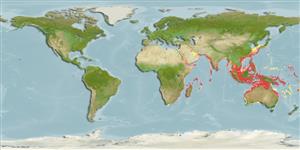Common names from other countries
分類 / Names
共通名の | 類義語 | Catalog of Fishes(部類, 種) | ITIS | CoL | WoRMS | Cloffa
>
Scombriformes (Mackerels) >
Scombridae (Mackerels, tunas, bonitos) > Scombrinae
Etymology: Rastrelliger: Latin, rastra = rake + Latin, gero = to carry.
More on author: Cuvier.
Environment: milieu / climate zone / depth range / distribution range
生態学
海; 海洋回遊性 (Ref. 51243); 深さの範囲 20 - 90 m (Ref. 12260). Tropical; 17°C - ? (Ref. 54861); 38°N - 36°S, 20°E - 180°E (Ref. 54861)
Indo-West Pacific: Red Sea and East Africa to Indonesia, north to the Ryukyu Islands and China, south to Australia, Melanesia and Samoa. Entered the eastern Mediterranean Sea through the Suez Canal.
Length at first maturity / サイズ / 重さ / 年齢
Maturity: Lm 21.0, range 17 - 24.5 cm
Max length : 36.0 cm オス/雌雄の選別がない; (Ref. 111654); 42.1 cm TL (female); common length : 25.0 cm TL オス/雌雄の選別がない; (Ref. 30573); 最大公表体重: 0.00 g; 最大記録サイズ: 4 年 (Ref. 168)
背面の脊椎 (合計) : 8 - 11; 背鰭 (合計) : 12; 肛門の骨: 0; 臀鰭: 12. Head longer than body depth. Maxilla partly concealed, covered by lachrymal bone but extending to about hind margin of eye. Bristles on longest gill raker 105 on one side in specimens of 12.7 cm, 140 in 16 cm, and 160 in 19 cm fork length specimens. A black spot on body near lower margin of pectoral fin. Interpelvic process small and single. Swim bladder present. Anal spine rudimentary.
Adults occur in coastal bays, harbors and deep lagoons, usually in some turbid plankton-rich waters. Form schools. Feed on phytoplankton (diatoms) and small zooplankton (cladocerans, ostracods, larval polychaetes, etc.) (Ref. 9684). Small groups were seen eating eggs of Cheilio inermis straight after spawning (Ref. 48637). Adult individuals feed on macroplankton such as larval shrimps and fish. Eggs and larvae are pelagic (Ref. 6769). Generally marketed fresh, frozen, canned, dried-salted, and smoked; also made into fish sauce (Ref. 9684).
Collette, B.B. and C.E. Nauen, 1983. FAO Species Catalogue. Vol. 2. Scombrids of the world. An annotated and illustrated catalogue of tunas, mackerels, bonitos and related species known to date. Rome: FAO. FAO Fish. Synop. 125(2):137 p. (Ref. 168)
CITES (Ref. 128078)
Not Evaluated
Human uses
水産業: 高い商業の; ゲームフィッシュ: はい; 餌: occasionally
用具
特記事項
XMLをダウンロードして下さい
インターネットの情報源
Estimates based on models
Preferred temperature (Ref.
115969): 23.7 - 28.3, mean 27.3 (based on 491 cells).
Phylogenetic diversity index (Ref.
82804): PD
50 = 0.6250 [Uniqueness, from 0.5 = low to 2.0 = high].
Bayesian length-weight: a=0.00871 (0.00767 - 0.00989), b=3.07 (3.04 - 3.10), in cm Total Length, based on LWR estimates for this species (Ref.
93245).
栄養段階 (Ref.
69278): 3.3 ±0.38 se; based on food items.
回復力 (Ref.
120179): 手段, 1.4年~4.4年の倍増期間の最小個体群 (K=0.2-1.9; tm=0.5-1; tmax=4; Fec = 37,690).
Prior r = 0.62, 95% CL = 0.41 - 0.93, Based on 1 full stock assessment.
Fishing Vulnerability (Ref.
59153): Low vulnerability (17 of 100).
Climate Vulnerability (Ref.
125649): Moderate to high vulnerability (52 of 100).
